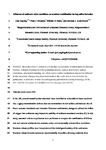Influence of sediment redox conditions on uranium mobilisation during saline intrusion
| dc.contributor.author | Eagling, J | |
| dc.contributor.author | Worsfold, Paul | |
| dc.contributor.author | Blake, William | |
| dc.contributor.author | Keith-Roach, MJ | |
| dc.date.accessioned | 2014-08-05T10:04:29Z | |
| dc.date.available | 2014-08-05T10:04:29Z | |
| dc.date.issued | 2013-08-28 | |
| dc.identifier.issn | 0009-2541 | |
| dc.identifier.issn | 1872-6836 | |
| dc.identifier.uri | http://hdl.handle.net/10026.1/3059 | |
| dc.description | This research was funded by the Natural Environment Research Council (grant NE/C506799/1: Studentship NE/H527116/1). | |
| dc.description.abstract |
In the UK, several coastal nuclear sites have been identified as vulnerable to future sea level rise. Legacy contamination at these sites has accumulated in sub-surface sediments at risk of future seawater inundation and intrusion. Porewater salinization, changes in pH and the influx of oxygen into sediments may impact the stability of sediment associated uranium (U). In this study, saturated column experiments were performed to compare the mobilisation of U from oxic and reduced sediments into seawater under environmentally relevant flow conditions. Uranium release profiles were independent of the initial geochemistry of the sediments. Uranium release from the sediments was kinetically controlled, showing relatively slow desorption kinetics, with release initially limited by the impact of the sediments on the pH of the seawater. Significant U release only occurred when the pH was sufficiently high for the formation of U-carbonate complexes (pHoxic 6.3; pHreduced 7.5). Uranium was more strongly bound to the reduced sediments and after 400 pore volumes of seawater flow, release was more extensive from the initially oxic (46%) compared with initially nitrate reducing (27%) and iron reducing (18%) sediments. The products of iron cycling appeared to act as a buffer limiting U mobilisation, but the on-going dissolution of the Fe-phases suggests that they did not form a permanent protective layer. © 2013 Elsevier B.V. | |
| dc.format.extent | 158-163 | |
| dc.language | en | |
| dc.language.iso | en | |
| dc.publisher | Elsevier BV | |
| dc.subject | Uranium | |
| dc.subject | Porewater salinization | |
| dc.subject | Desorption | |
| dc.subject | Transport | |
| dc.subject | Oxic and reduced sediments | |
| dc.subject | Oxidation | |
| dc.title | Influence of sediment redox conditions on uranium mobilisation during saline intrusion | |
| dc.type | journal-article | |
| dc.type | Article | |
| plymouth.author-url | https://www.webofscience.com/api/gateway?GWVersion=2&SrcApp=PARTNER_APP&SrcAuth=LinksAMR&KeyUT=WOS:000326572300014&DestLinkType=FullRecord&DestApp=ALL_WOS&UsrCustomerID=11bb513d99f797142bcfeffcc58ea008 | |
| plymouth.volume | 357 | |
| plymouth.publication-status | Published | |
| plymouth.journal | CHEMICAL GEOLOGY | |
| dc.identifier.doi | 10.1016/j.chemgeo.2013.08.030 | |
| plymouth.organisational-group | /Plymouth | |
| plymouth.organisational-group | /Plymouth/Admin Group - REF | |
| plymouth.organisational-group | /Plymouth/Admin Group - REF/REF Admin Group - FoSE | |
| plymouth.organisational-group | /Plymouth/Faculty of Science and Engineering | |
| plymouth.organisational-group | /Plymouth/Faculty of Science and Engineering/School of Geography, Earth and Environmental Sciences | |
| plymouth.organisational-group | /Plymouth/REF 2021 Researchers by UoA | |
| plymouth.organisational-group | /Plymouth/REF 2021 Researchers by UoA/UoA14 Geography and Environmental Studies | |
| plymouth.organisational-group | /Plymouth/Research Groups | |
| plymouth.organisational-group | /Plymouth/Research Groups/BEACh | |
| plymouth.organisational-group | /Plymouth/Research Groups/Marine Institute | |
| plymouth.organisational-group | /Plymouth/Users by role | |
| plymouth.organisational-group | /Plymouth/Users by role/Academics | |
| plymouth.organisational-group | /Plymouth/Users by role/Researchers in ResearchFish submission | |
| dcterms.dateAccepted | 2013-08-18 | |
| dc.rights.embargodate | 2014-8-28 | |
| dc.identifier.eissn | 1872-6836 | |
| dc.rights.embargoperiod | Not known | |
| rioxxterms.versionofrecord | 10.1016/j.chemgeo.2013.08.030 | |
| rioxxterms.licenseref.uri | http://www.rioxx.net/licenses/all-rights-reserved | |
| rioxxterms.licenseref.startdate | 2013-08-28 | |
| rioxxterms.type | Journal Article/Review |


